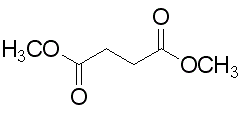All AbMole products are for research use only, cannot be used for human consumption.

Dimethyl succinate is a biodegradable ester with low odor and low volatility and commonly serves as a flavoring agent that can be used in perfumery and personal are products, including skin-conditioning agents and emollient. Besides, dimethyl succinate can be used in the production of pharmaceuticals as well as agrochemicals and for manufacturing additives, plastics and other organic compounds.

Animals (Basel). 2024 Mar 25;14(7):999.
Effects of Succinate on Growth Performance, Meat Quality and Lipid Synthesis in Bama Miniature Pigs
Dimethyl succinate (Standard for GC) purchased from AbMole
| Molecular Weight | 146.14 |
| Formula | C6H10O4 |
| CAS Number | 106-65-0 |
| Solubility (25°C) | Soluble in acetone Water 3 mg/mL |
| Storage | RT |
| Related Products |
|---|
| Myoglobin (from equine skeletal muscle)
Myoglobin is a small molecular pigment protein formed by binding globin to Heme, which can be reversibly bound to oxygen to form MbO2, MbO2 is called oxymyoglobin, and Mb is called deoxymyoglobin. Myoglobin has the role of transporting and storing oxygen in muscle cells. |
| Hemoglobin (from bovine blood)
Hemoglobin is a iron-containing protein in red blood cells with oxygen binding properties. Hemoglobin is an inducer of HO-1. Hemoglobin consits of heme, which binds to oxygen. Hemoglobin also transports other gases, such as carbon dioxide, nitric oxide, hydrogen sulfide and sulfide. |
| Diethylenetriaminepentaacetic dianhydride
Diethylenetriaminepentaacetic dianhydride (DTPA anhydride) is a bifunctional chelator whose anhydride can react with amino groups in proteins (such as lysine residues) to form stable amide bonds. Diethylenetriaminepentaacetic dianhydride (DTPA anhydride) can also bind to radionuclides to synthesize radionuclide-labeled drug conjugates (RDCs). |
| 3-Phenylthiophene
3-Phenylthiophene is a biochemical material that can be used in scientific research. 3-Phenylthiophene is a conducting polymer precursor. |
| DSPE-PEG-FA
DSPE-PEG2K-FA is a PEG derivative containing folic acid. DSPE-PEG2K-FA has a targeting effect and can bind to folic acid receptors in cancer cells. DSPE-PEG2K-FA forms micelles/lipid bilayers and can be used in research on targeted drug delivery systems. |
All AbMole products are for research use only, cannot be used for human consumption or veterinary use. We do not provide products or services to individuals. Please comply with the intended use and do not use AbMole products for any other purpose.


Products are for research use only. Not for human use. We do not sell to patients.
© Copyright 2010-2024 AbMole BioScience. All Rights Reserved.
